历史
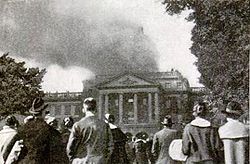
Fire at Bascom Hall which destroyed the dome in 1916
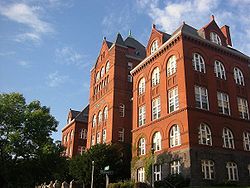
Science Hall, listed on the National Register of Historic Places, was partly designed by former UW–Madison student Frank Lloyd Wright
The university had its official beginnings when Wisconsin was incorporated as a state in 1848. The Wisconsin Constitution provided for "the establishment of a state university, at or near the seat of state government..." and directed by the state legislature to be governed by a board of regents and administered by a chancellor. On July 26, 1848, Nelson Dewey, Wisconsin's first governor, signed the act that formally created the University of Wisconsin. John H. Lathrop became the university's first chancellor, in the fall of 1849. With John W. Sterling as the university's first professor (mathematics), the first class of 17 students met at Madison Female Academy on February 5, 1849. A permanent campus site was soon selected: an area of 50 acres (200,000 m²) "bounded north by Fourth lake, east by a street to be opened at right angles with King street," [later State Street] "south by Mineral Point Road (University Avenue), and west by a carriage-way from said road to the lake." The regents' building plans called for a "main edifice fronting towards the Capitol, three stories high, surmounted by an observatory for astronomical observations." This building, University Hall, now known as Bascom Hall, was finally completed in 1859. On October 10, 1916, a fire destroyed the building's dome, which was never replaced. North Hall, constructed in 1851, was actually the first building on campus. In 1854, Levi Booth and Charles T. Wakeley became the first graduates of the university, and in 1892 the university awarded its first Ph.D. to future university president Charles R. Van Hise.
The Wisconsin Idea
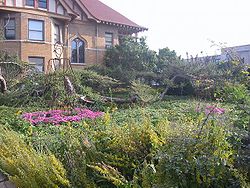
Located on the west end of campus, the Allen Centennial Gardens are maintained by the College of Agriculture and Life Sciences.
Research, teaching, and service at the UW is influenced by a tradition known as "the Wisconsin Idea," first articulated by UW–Madison President Charles Van Hise in 1904, when he declared "I shall never be content until the beneficent influence of the University reaches every home in the state." The Wisconsin Idea holds that the boundaries of the university should be the boundaries of the state, and that the research conducted at UW–Madison should be applied to solve problems and improve health, quality of life, the environment, and agriculture for all citizens of the state. The Wisconsin Idea permeates the university’s work and helps forge close working relationships among university faculty and students, and the state's industries and government. Based in Wisconsin's populist history, the Wisconsin Idea continues to inspire the work of the faculty, staff, and students who aim to solve real-world problems by working together across disciplines and demographics.
Expansion
Main article: University of Wisconsin System
Over time, additional campuses were added to the University. The University of Wisconsin–Milwaukee was created in 1956, and UW–Green Bay and UW–Parkside in 1968. Ten freshman-sophomore centers were also added to this system. In 1971, Wisconsin legislators passed a law merging the University of Wisconsin with the nine universities and four freshman-sophomore branch campuses of the Wisconsin State Universities System, creating the University of Wisconsin System and bringing the two higher education systems under a single board of regents.
Student activism
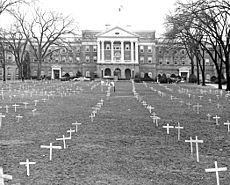
Bascom Hill, 1968, with crosses placed by students protesting the Vietnam War, and sign reading, "BASCOM MEMORIAL CEMETERY, CLASS OF 1968"
In the late 1960s and early 1970s, UW–Madison was shaken by a series of student protests, and by the use of force by authorities in response, comprehensively documented in the film The War at Home. The first major demonstrations protested the presence on campus of recruiters for the Dow Chemical Company, which supplied the napalm used in the Vietnam War. Authorities used force to quell the disturbance. The struggle was documented in the PBS documentary Two Days in October, as well as the book, They Marched Into Sunlight. Among the students injured in the protest was future Madison mayor Paul Soglin.
Another target of protest was the Army Mathematics Research Center (AMRC), located in Sterling Hall. The student newspaper, The Daily Cardinal, published a series of investigative articles that made a convincing case that AMRC was pursuing research directly pursuant to US Department of Defense requests, and supportive of military operations in Vietnam. AMRC became a magnet for demonstrations, in which protesters chanted "U.S. out of Vietnam! Smash Army Math!"
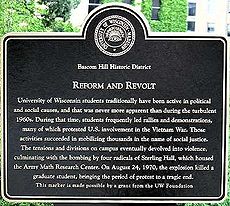
Sign near Sterling Hall commemorating fatal 1970 bomb attack
On August 24, 1970, near 3:40 AM, a bomb exploded next to Sterling Hall, aimed at destroying the Army Math Research Center. Despite the late hour, a post-doctoral physics researcher, Robert Fassnacht, was in the lab and was killed in the explosion. The physics department was damaged worse than the intended target, the AMRC. Karleton Armstrong, Dwight Armstrong, and David Fine were found responsible for the blast. Leo Burt was identified as a suspect, but was never apprehended or tried. The story of this event is told in the book Rads.
Timeline of notable events
|
|
This article is in a list format that may be better presented using prose. You can help by converting this article to prose, if appropriate. Editing help is available. (December 2008) |
Other notable historical moments in the first 150 years of the University of Wisconsin–Madison include:
- 1863 Women students first admitted to University of Wisconsin during the American Civil War ,,
- 1866 State legislature designated the University as the Wisconsin land-grant institution
- April 4, 1892 The first edition of the student-run The Daily Cardinal was published
- 1894 State Board of Regents rejected an effort to purge Professor Richard T. Ely for supporting striking printers, issuing the famous "sifting and winnowing" manifesto in defense of academic freedom, later described as "part of Wisconsin's Magna Carta"[8]
- 1898 UW music instructor Henry Dyke Sleeper wrote Varsity, the university’s alma mater
- 1904–1905 UW Graduate School established
- 1905 – the University awards the first Ph.D. in chemical engineering ever granted, to Oliver Patterson Watts.
- 1907 Wisconsin Union was founded
- 1909 William Purdy and Paul Beck wrote On, Wisconsin the UW–Madison athletic fight song
- 1907–1911 The "Single-grain Experiment" was conducted by Stephen Moulton Babcock and Edwin B. Hart, paving the way for modern nutrition as a science
- 1913 Vitamin A discovered by UW scientist, Elmer V. McCollum
- 1916 Vitamin B discovered by McCollum
- 1919 Radio station 9XM founded on campus (Now WHA (970 AM), it is the oldest continually-operating radio station in the United States)
- 1923 Harry Steenbock invented process for adding vitamin D to milk
- 1925 Wisconsin Alumni Research Foundation chartered to control patenting and patent income on UW–Madison inventions
- 1934 The University of Wisconsin–Madison Arboretum, whose mission was to restore lost landscapes, such as prairies, was opened
- 1936 UW–Madison began an artist-in-residence program, the first ever at a university
- 1940–1951 Warfarin (Coumadin) developed at UW. Named after Wisconsin Alumni Research Foundation
- 1969 The Badger Herald was founded as a conservative student paper
- 1970 Sterling Hall bombing
- 1984 University Research Park founded to encourage technology transfer between university and businesses
- 1988 The Onion founded by two UW–Madison students, Tim Keck and Christopher Johnson
- 1998 UW–Madison's James Thomson (cell biologist) first isolated and cultured human embryonic stem cells
学术
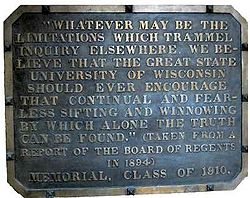
"Sifting and winnowing" plaque on Bascom Hall, UW–Madison tribute to academic freedom
The University of Wisconsin–Madison, the flagship campus of the University of Wisconsin System, is a large, four-year research university comprising twenty associated colleges and schools. In addition to undergraduate and graduate divisions in agriculture and life sciences, business, education, engineering, human ecology, journalism and mass communication, letters and science, music, nursing, pharmacy, and social welfare, the university also maintains graduate and professional schools in environmental studies, law, library and information studies, medicine and public health, public affairs, and veterinary medicine.
The four year, full-time undergraduate instructional program is classified by the Carnegie Foundation for the Advancement of Teaching as "arts and science plus professions" with a high graduate coexistence; admissions are characterized as "more selective, lower transfer-in." The largest university college, the College of Letters and Science, enrolls approximately half of the undergraduate student body and is made up of thirty-nine departments and five professional schools that instruct students and carry out research in a wide variety of fields, such as astronomy, economics, geography, history, linguistics, and zoology. The graduate instructional program is classified by Carnegie as "comprehensive with medical/veterinary." In 2008, it granted the third largest number of doctorates in the nation..
Rankings
|
|
University rankings (overall)
|
|
| ARWU World |
17th |
| ARWU North & Latin America |
15th |
| Times Higher Education |
55th |
| USNWR National University |
35th |
International
The UW was ranked 17th among world universities and 15th among universities in the Americas in Shanghai Jiao Tong University's 2008 Academic Ranking of World Universities, which assesses academic and research performance. In the G-factor International University Ranking of 2006, which is a re-analysis of the Shanghai Jiao Tong University data, the UW–Madison was listed 13th. The Times Higher Education Supplement placed it 55th worldwide, based primarily on surveys administered to students, faculty, and recruiters. Additionally, the professional ranking of world universities from École Nationale Supérieure des Mines de Paris, based in part on the number of senior managerial positions occupied by alumni, placed UW–Madison 35th in the world. In the Webometrics ranking, which is based on a combined indicator that takes into account both the volume of the Web contents and the visibility and impact of web publications, UW–Madison ranked 7th worldwide.
National
UW–Madison was ranked 11th among national universities (with three institutions tied) by the Center for Measuring University Performance in its 2007 report, with rankings based on objective statistics on research, faculty awards, student qualifications, and university assets. Of 38 programs at the UW–Madison that were included in the National Research Council's 1995 study, 16 ranked in the top 10 nationally. In 2007, the Chronicle of Higher Education reported that 57 disciplines at the UW–Madison were in the top 10 in the U.S. in scholarly productivity, which placed it second after UC-Berkeley in the number of top ten programs. According to the Gourman report, its graduate programs were ranked eighth best overall, and third best among public universities after the University of California, Berkeley and the University of Michigan. The UW placed 30th among national universities in Washington Monthly's 2009 rankings, which consider community service and social mobility, as well as research productivity. In 2009, UW–Madison was ranked 6th in Internet Media Buzz by the Global Language Monitor.
Madison's undergraduate program was ranked 35th among national universities by U.S.News & World Report for 2009. The same magazine ranked UW's graduate School of Business 29th, and its undergraduate business program 13th. Twelve CEOs of S&P 500 companies hold degrees from the University of Wisconsin, putting it in a tie with Harvard and Princeton for first place.
In 2010, USNWR ranked UW's Law School 28th, while Vault listed it as 25th for 2008. Other graduate schools ranked by USNWR include the School of Medicine and Public Health, which was 27th in research and 13th in primary care, the College of Engineering 16th, the School of Education 12th, and the La Follette School of Public Affairs 14th.
Madison has been labeled one of the "Public Ivies," a publicly-funded university considered as providing a quality of education comparable to those of the Ivy League. In the Gourman Report on undergraduate programs, the University of Wisconsin–Madison was ranked the third-best public university, after the University of California, Berkeley and the University of Michigan. Additionally, it was ranked the seventh-best university in the United States for overall strength of the undergraduate programs.
In 2009, Madison was ranked 415th by Forbes on their list of the 600 best colleges in America, one of the few publicly funded schools to make the list that was dominated by private universities.
Research
UW–Madison was a founding member of the Association of American Universities. In 2007–2008, the school allocated $832 million towards research on campus, placing it second in the country in generating research funding, behind Johns Hopkins University. Collectively, its research programs were also sixth in the number of patents issued in 2005.
Overall, the University maintains almost 100 research centers and programs, ranging from agriculture to arts, from education to engineering. It has been considered a major academic center for embryonic stem cell research ever since UW–Madison professor James Thomson became the first scientist to isolate human embryonic stem cells. This has brought significant attention and respect for the University's research programs from around the world. The University continues to be a leader in stem cell research, helped in part by the funding of the Wisconsin Alumni Research Foundation and promotion of WiCell.
Its center for research on internal combustion engines, called the Engine Research Center, has a five-year collaboration agreement with General Motors. It has also been the recipient of multi-million dollar funding from the federal government.
The University of Wisconsin–Madison is one of thirty sea grant colleges in the United States. These colleges are involved in scientific research, education, training, and extension projects geared toward the conservation and practical use of U.S. coasts, the Great Lakes and other marine areas.
In January 2008, the US Department of Agriculture cited the University of Wisconsin–Madison Research Animal Resource Center for multiple violations of the Animal Welfare Act, including not using painkillers in animals undergoing painful procedures, improper monitoring of animals, and not reporting medical problems to staff veterinarians.
Letters & Science Honors Program
The L&S Honors Program serves over 1,700 students in the College of Letters and Science (the UW–Madison's liberal arts college) with an enriched undergraduate curriculum. In addition to its curriculum, the program offers professional advising services, grants, scholarships, and awards, and numerous academic, social, and service opportunities through the Honors Student Organization. The Honors Program also supports several student organizations, such as the University of Wisconsin–Madison Forensics Team.
校园
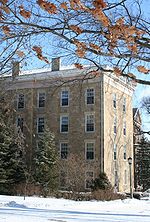
North Hall, the first building on campus
Located in Madison, about a mile from the state capitol, the university is situated partially on an isthmus between Lake Mendota and Lake Monona. The main campus comprises 933 acres (3.77 km²) of land, while the entire campus, including research stations located throughout the state, is over 10,600 acres (42.9 km²) in area. The University of Wisconsin–Madison Arboretum, a demonstration area for native ecosystems, is located on the west side of Madison. The main campus includes many buildings designed or supervised by architects J.T.W. Jennings and Arthur Peabody. The hub of campus life is the Memorial Union.
The UW–Madison has its own police force, food service, hospital, recreation facilities, botanical gardens, power facilities, and an on-campus dairy.
Bascom Hall
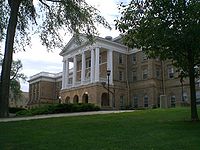
Bascom Hall atop Bascom Hill at the heart of the campus.
As one of the icons on campus, Bascom Hall, at the top of Bascom Hill, is often considered the "heart of the campus." Built in 1857, a decorative dome that once sat atop the structure was destroyed by fire. The structure has been added to several times over the years. The building currently houses the office of the chancellor and vice chancellors. Bascom Hall is listed on the National Register of Historic Places as a contributing building within the Bascom Hill Historic District.
Music Hall
This Victorian Gothic building, built in 1878 and initially named Assembly Hall, was designed to house an 800-seat auditorium, a library, and a clock tower. Dedicated on March 2, 1880, the building originally held conventions, dances, and commencement ceremonies, along with its primary purpose of a library. After the library moved to a different building on campus, a portion of the hall was assigned to the School of Music in 1900. Shortly after renovations in the early 1900s, the building was officially named Music Hall in 1910. It remains an important music venue and is home to the university opera. This building also is home to the Department of Urban and Regional Planning, with part of the building being used as office space and classrooms.
George L. Mosse Humanities Building
The George L. Mosse Humanities Building, located on Library Mall, was built in the late 1960s in the Brutalist style. Campus myth has it that the building (with its poor ventilation, narrow windows, inclined base, and cantilevered upper floors) was designed to be "riot-proof" in that it was inescapable by protestors and easily penetratable by a SWAT Team. Its seven floors house the History, Art, and Music departments. The most recent Campus Master Plan calls for it to be demolished and replaced with two other buildings.
Grainger Hall
Home of the Wisconsin School of Business, Grainger Hall was built in 1993. It recently underwent a major renovation and addition to assist the 12 MBA specialization programs that were housed there. The addition occupies the corner of Park Street and University Avenue, projecting the school’s crest outward in a location that once housed a bank.
The Wisconsin Union
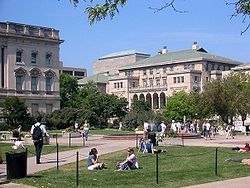
The Memorial Union as seen from the Library Mall on the UW–Madison campus
The University of Wisconsin–Madison is home to two student unions. The older, Memorial Union, was built in 1928 to honor American World War I veterans. Also known as the Union or the Terrace, it has gained a reputation as one of the most beautiful student centers on a university campus. Located on the shore of Lake Mendota, it is a popular spot for socializing among both students and the public, who enjoy gazing at the lake and the sailboats that are often present. The union is known for the Rathskeller, a German pub adjacent to the lake terrace. Political debates and backgammon and sheepshead games over a beer on the terrace are common among students . The Rathskeller serves "Rathskeller Ale," a beer brewed expressly for the Terrace. It was also the first union at a public university to serve beer.
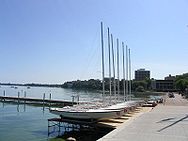
Hoofer Badger Sloops on Lake Mendota behind Memorial Union
Memorial Union is home to many arts venues, including several art galleries, a movie theater, the Wisconsin Union Theater, and the Craftshop, which provides courses and facilities for engaging in a variety of arts and crafts. The Memorial Union was also home to the only business on campus owned and operated solely by students, ASM StudentPrint, until 2009 when it moved to 333 East Campus Mall. Students and Madison community members alike congregate at the Memorial Union for the films and concerts each week. An advisory referendum to renovate and expand Memorial Union was approved by the student body, and the university is currently in the planning phase for the expansion.
Union South, the newer campus union, existed at the southwest end of campus until its demolition in 2008. It was built in the 1970s to alleviate the pressure for space on Memorial Union. Plans to construct a new "green" Union South were approved by the student body and the new building is now rising. Union South mainly served users of the UW–Madison's science-related buildings, but was also a home for social and recreational activities, including weekly dances by student groups, music and film series, and bowling leagues. The Wisconsin Union also provides a home for the Wisconsin Union Directorate Student Programming Board (WUD), which provides regular programs for both students and community members. One of the most well-known members of WUD is the Wisconsin Hoofers, a club involved in organized outdoor recreational activities.
Libraries
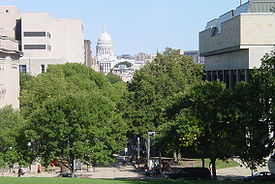
A view of the Wisconsin State Capitol from atop Bascom Hill. The Mosse Humanities building is on the right, Wisconsin Historical Society (fore) and Memorial Library (rear) on the left
Wisconsin had the 13th largest research library collection in North America in 2007–08, according to the Association of Research Libraries. Memorial Library, along with more than 40 other professional and special-purpose libraries, serve the campus. As of July 2008, the campus library collections included more than 8.1 million volumes representing human inquiry through all of history. In addition, the collections comprised more than 76,000 serial titles, 6.4 million microfilm items, and over 7 million items in other formats, such as government documents, maps, musical scores, and audiovisual materials. Over 1 million volumes are circulated to library users every year. Memorial Library serves as the principal research facility on campus for the humanities and social sciences. It houses the largest single library collection in the state of Wisconsin—-more than 3.5 million volumes. This library also houses an extensive periodical collection, a large selection of domestic and foreign newspapers, Special Collections, the University Archives, the Mills Music Library, a letterpress printing museum, and the UW Digital Collections Center.
Undergraduates can find many of the resources they need at College Library in Helen C. White Hall. Special collections there include Ethnic Studies, Career, Women's and Gaus (Poetry). The Open Book collection, created to support the extra-academic interests of undergraduates, features DVDs, audio books, and video games, along with paperback books. The library also has a coffee shop, the Open Book Café. College Library houses an extensive media center with over 200 computer workstations available for student use, DV editing stations, scanners, poster printing, and equipment checkout (including laptops, digital cameras, projectors, and more).
The Kurt F. Wendt Library serves the College of Engineering and the Departments of Computer Sciences, Statistics, and Atmospheric & Oceanic Sciences. In addition to books, journals, and standards, Wendt Library houses over 1.5 million technical reports in print and microfiche. Designated a Patent and Trademark Depository Library, it maintains all U.S. utility, design, and plant patents, and provides reference tools and assistance for both the general public and the UW–Madison community.
Ebling Library for the Health Sciences is located in the Health Sciences Learning Center. It opened in 2004 after the Middleton Library, Weston Library, and Power Pharmaceutical Library merged collections and staff.
The online catalog for UW–Madison Libraries is MadCat. It includes bibliographic records for books, periodicals, audiovisual materials, maps, music scores, microforms, and computer databases currently owned by over 40 campus libraries, as well as records for items that are on order. The UW–Madison Libraries website provides access to a number of resources licensed for use by those affiliated with UW–Madison, in addition to those openly available on the World Wide Web.
Museums
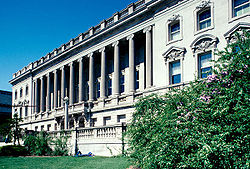
Wisconsin Historical Society
The Geology Museum features rocks, minerals, and fossils from around the world. Highlights include a blacklight room, a walk-through cave, and a fragment of the Barringer meteorite. Some noteworthy fossils include the first dinosaur skeleton assembled in Wisconsin (an Edmontosaurus), a shark (Squalicorax) and a floating colony of sea lilies (Uintacrinus), both from the Cretaceous chalk of Kansas, and the Boaz Mastodon, a found on a farm in southwestern Wisconsin in 1897.
The Chazen Museum of Art, formerly the Elvehjem Museum of Art, maintains a collection of paintings, drawings, sculpture, prints and photographs spanning over 700 years of art.
The university's Zoological Museum maintains a collection of approximately 500,000 zoological specimens, which can be used for research and instruction. A special collection contains skeletons, artifacts, and research papers associated with the Galápagos Islands. Since 1978, the UW–Madison Zoological Museum has been one of only three museums granted permission by the Ecuadoran Government to collect anatomical specimens from the Galápagos Islands.
The L. R. Ingersoll Physics Museum contains a range of exhibits demonstrating classical and modern physics. Many of the exhibits allow for hand-ons interaction by visitors. The museum also has a number of historical instruments and pictures on display.
Charter Street Power Plant
Located 2 blocks south of the busiest part of campus is the University's coal-burning heating plant. The 9.8 MW power plant opened in the mid 1950s, and produces a little over 50 million kilowatt hours of electricity every year. On May 3, 2007, the Sierra Club filed a lawsuit against the university alleging violations of the Clean Air Act. The plant does not use modern pollution controls such as scrubbers, catalytic reduction, or carbon injection. In 2006–2007, the editorial boards of local papers called for the elimination or phasing-out of the coal power plant.
In June 2007 it was reported that runoff from the coal pile behind the Charter St. plant may be draining into the storm water system and that the pollutants could contain arsenic and other heavy metals. Governor Doyle has called for a phase-out of coal power on the UW campus by 2012.
体育运动
Main article: Wisconsin Badgers
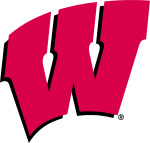
The Wisconsin Badgers "Motion W" logo
The University of Wisconsin–Madison sports teams participate in the NCAA's Division I-A. With the exception of men's and women's hockey and men and lightweight women's rowing (Wisconsin Crew), University of Wisconsin–Madison athletic programs compete in the Big Ten Conference. Both hockey programs compete in the Western Collegiate Hockey Association, while the traditionally highly ranked men's and lightweight women's crew programs compete in the Eastern Association of Rowing Colleges. The school's fight song is On, Wisconsin!. The school's mascot is Buckingham U. Badger, commonly referred to as "Bucky Badger".
2005–06 marked the first time in school history that four Badger teams brought home national championships in the same academic year. In the fall, the men's cross country team won its fourth national championship, after finishing second the previous three years. The winter season was highlighted by the men's and women's ice hockey teams both winning national titles. The year was capped off in the spring with the women's lightweight crew taking its third straight Intercollegiate Rowing Association national crown. In 2008, both men's and women's crew teams claimed national titles.
Football
Main article: Wisconsin Badgers football
The Badgers play college football at the 80,321 capacity Camp Randall Stadium. After every game, the University of Wisconsin Marching Band plays popular songs during the Fifth Quarter. The Badgers' current head coach Bret Bielema succeeded long-time head coach and current athletic director Barry Alvarez in 2006. The Badgers won three Rose Bowl Championships under Alvarez in 1994, 1999, and 2000. In 2006, Bielema led the Badgers to school record eleven-win regular season and to twelve overall wins after defeating Arkansas in the Capital One Bowl.
Men's basketball
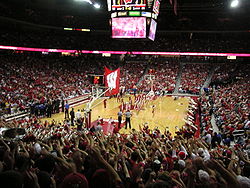
Men's basketball game as seen from the student section at the Kohl Center
Main article: Wisconsin Badgers men's basketball
The Badgers have made 11 consecutive appearances at the NCAA Tournament, with a Final Four visit in 2000 and an Elite Eight appearance in 2005. Badgers' head coach Bo Ryan, a four-time Division III national championship coach at the University of Wisconsin–Platteville, has coached the team since 2001. The Badgers play at the Kohl Center, where the student fans are known as the Grateful Red. In the 2006–2007 basketball season, the Badgers attained their highest AP ranking in school history (#1, Feb. 19–25), garnering 35 first-place votes. The Badgers' earned their only NCAA National Championship in 1941.
Women's basketball
Main article: Wisconsin Badgers women's basketball
The women's basketball team is led by Head Coach Lisa Stone and Frances Pomeroy Naismith Award winner Jolene Anderson. The Lady Badgers also play at the Kohl Center since their move from the Wisconsin Field House in 1998. The 2006–2007 season was a record-setting year as the Badgers recorded 23 wins, including 17 home wins, and were the WNIT Runner-Up Champions.
Ice hockey
Main article: Wisconsin Badgers men's ice hockey
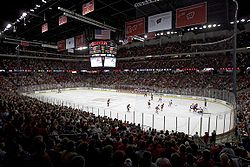
Men's hockey game played at the Kohl Center
Badger ice hockey first became a men's varsity sport in 1922. Although dropped after the 1934–35 season, it again became a varsity sport in the 1963–64 season. The men's team played in the Dane County Coliseum until moving to the Kohl Center (capacity 15,237) in the fall of 1998. The first ice hockey game played at the Kohl was the Hall of Fame game against the University of Notre Dame. The men's team perennially leads the nation in college hockey attendance, and set an NCAA attendance record (averaging 14,430) during the 2006–07 season, surpassing their previous record set the previous year.
Bob Johnson, nicknamed "Badger Bob" by fans, took over the reins in 1966. Johnson coached the Badger men to three national championships in 1973, 1977 and 1981. Jeff Sauer coached the Badger men to two more titles in 1983 and 1990. Mike Eaves, member of the 1977 NCAA title team, coached the Badger men's team to its sixth national championship in 2006. The six Badger titles rank 4th in NCAA men's ice hockey history. Eaves' 2010 squad advanced to the national championship game during the Badgers' 11th appearance in the men's Frozen Four before bowing to Boston College.
The school's strong ice hockey tradition gained another dimension with the addition of a women's team that began play in the 1999–2000 season. Coached by Mark Johnson, son of "Badger Bob" and another member of the men's 1977 title team, the Badger women won their first NCAA championship on March 26, 2006. The dual 2006 titles marked the first time that both the men's and women's Division I NCAA hockey titles were won by the same school in the same year. The women's team repeated as national champions in 2007 with a victory over the University of Minnesota-Duluth on March 18 at Herb Brooks Arena in Lake Placid, NY. With a 5-0 victory over Mercyhurst in the 2009 Women's Frozen Four final in Boston, the Badger women added their third NCAA title.
Rivalries
The Wisconsin Badgers compete in the Big Ten Conference. Their most notable rivalry is with the University of Minnesota, which is the most-played rivalry in Division 1-A football. In their annual college football game, the teams compete for Paul Bunyan's Axe. The two universities also compete in the Border Battle, a year-long athletic competition in which each team's wins earn points for their university.
The long-standing football rivalry between the University of Iowa and Wisconsin-Madison was finally recognized in 2004, with the winner of their annual game being awarded the Heartland Trophy. Madison and Marquette, located in Milwaukee, also have a non-conference basketball rivalry, which is driven both by intrastate loyalties and public-private differences in the schools.
Madison has natural rivals with other schools in the UW System, most notably Milwaukee and Green Bay
The Wisconsin-Madison men's and women's hockey teams' most recognized rivals are the Golden Gophers of the University of Minnesota and the Fighting Sioux of the University of North Dakota. Other rivals include the University of Denver, Colorado College, Michigan Tech, and St. Cloud State.
Mascot
The mascot is an anthropomorphized badger named Bucky who dons a sweater affixed with the UW–Madison athletic logo (currently the red "Motion W"). Beginning in 1890, the university's first Bucky Badger was a live, temperamental and unruly badger who was quickly retired. Although the nickname of the Wisconsin teams remained the "Badgers," it was not until Art Evans drew the early caricature version of Bucky in 1940 that today's recognizable image of Bucky was adopted. In 1949, a contest was held to name the mascot, but no consensus was reached after only a few entries were received. In reaction, the contest committee chose the name Buckingham U. Badger, or "Bucky," for short.
At Wisconsin football games in the 1920s live mascots were used to inspire fans. The animals used included a black bear, a bonnet monkey, and live badgers. 1949 was the first year a student sporting a papier-mâché badger head appeared; this subsequently replaced the use of live badgers.
The team's nickname originates from the state nickname. In the 1820s, many lead miners and their families lived in the mines in which they worked until adequate above-ground shelters were built, and thus were compared to badgers.
[edit] Student life
Over 750 student organizations or clubs register with the Center for Leadership and Involvement (CFLI) at UW–Madison each year.
Media
Student newspapers
UW–Madison is the only American university to have two competing daily student newspapers: The Daily Cardinal, founded in 1892 and The Badger Herald, founded in 1969. In addition, students also produce the liberal Madison Observer, founded in 2003, and the conservative Mendota Beacon, founded in 2005. The Onion was founded in 1988 by two UW–Madison juniors, and was published in Madison before moving to New York City in 2001.
Campus radio
The University of Wisconsin–Madison campus radio station is WSUM 91.7 FM. Historically, UW–Madison has been home to a collection of student run radio stations, a number of which stopped broadcasting after run-ins with the United States Federal Communications Commission (FCC). The current radio station, WSUM, began in 1997 in a webcast only format because of the prolonged battle to get an FCC license and construct a tower. This lasted five years until February 22, 2002, when the station started broadcasting over FM airwaves at 91.7 from its tower in Montrose, Wisconsin. The radio station currently has around 150 volunteer DJs and 8 paid managers. All UW–Madison students, as well as a limited number of community members, are eligible to participate in running the station. WSUM remains entirely free format, which means that the on-air personnel can showcase a large variety of music and talk programming at their discretion with few limitations. WSUM has garnered many awards from the Wisconsin Broadcasters Association for their news, play-by-play broadcasts of Badger athletic events, and unique public service announcements..
"Party school" image
Wisconsin was named the number three "party school" by Playboy magazine and number eight by Princeton Review in 2010. UW–Madison has long held a reputation for academics, political activism, and drinking; the last of these can be understood in the context of the state's traditionally high level of alcohol consumption in general.
The festive mentality is most notably displayed with the annual Mifflin Street Block Party and the State Street Halloween Party. The Mifflin Street Block Party, which began in the 1960s as a counterculture event, is today a spring semester finals week kickoff. Both events are commonly attended by tens of thousands of partiers, including many who come from out of state. Following a non-political riot that developed at the 1996 Mifflin Street Block Party, it was forcibly canceled by the city; since then, the city has permitted resumption of a Mifflin Street event.
MTV's College Life
On April 13, 2009, MTV premiered the reality series College Life about the day-to-day lives of eight UW–Madison freshmen. The show was created by UW–Madison alumnus David Wexler. According to MTV, the students do the filming for the series, but not the editing. During production, the university pulled its support of the show. Subsequently, a disclaimer is aired at the beginning of each episode stating that UW–Madison does not endorse the program.
UW–Madison alumni and notable people
Main article: List of University of Wisconsin–Madison people
UW-Madison has over 375,000 living alumni. Although a large number of alumni live in Wisconsin, a significant number live in Illinois, Minnesota, New York, California, and Washington, D.C. UW-Madison also has over 15,000 alumni living outside of the United States.
UW-Madison alumni, faculty, or former faculty have been awarded 17 Nobel Prizes and 26 Pulitzer Prizes.
更多
- University of Wisconsin (former)
- University of Wisconsin System
- Wisconsin Alumni Research Foundation
- Wisconsin Idea
- University of Wisconsin Law School
- University of Wisconsin School of Medicine and Public Health
- University of Wisconsin–Madison Arboretum
- UW–Madison Geology Museum
- Chazen Museum of Art
- Weinert Center for Entrepreneurship
- Undergraduate Projects Lab
- UW Hybrid Vehicle Team
- Wisconsin Hoofers
- Big Ten Conference
- Western Collegiate Hockey Association
- Camp Randall Stadium
- Kohl Center
- Wisconsin Badgers
- Wisconsin Badgers football
- Wisconsin Badgers men's basketball
- University of Wisconsin Marching Band
参考文献
- ^ Ask Abe Archives - Campus Traditions
- ^ http://www.wisc.edu/about/facts/community.php#community
- ^ The Wisconsin Idea
- ^ "National Historic Landmarks Program". National Park Service. http://tps.cr.nps.gov/nhl/default.cfm. Retrieved September 19, 2008.
- ^ "Community, Students, and Degrees". University of Wisconsin–Madison. http://www.wisc.edu/about/facts/community.php. Retrieved April 5, 2009.
- ^ "Academic Programs and Resources". University of Wisconsin. http://www.wisc.edu/about/facts/acprograms.php. Retrieved April 5, 2009.
- ^ "University of Wisconsin–Madison". Carnegie Foundation for the Advancement of Teaching. http://www.carnegiefoundation.org/classifications/sub.asp?key=748&subkey=16731&start=782. Retrieved June 30, 2008.
- ^ "Academic R&D Expenditures: FY 2008". National Science Foundation. http://www.nsf.gov/statistics/nsf10311/. Retrieved 2010-04-10.
- ^ "The Association of American Universities: A Century of Service to Higher Education". Association of American Universities. http://www.aau.edu/WorkArea/showcontent.aspx?id=1090. Retrieved September 19, 2008.
- ^ "Madison, Wisconsin, Oct. 10, 1916: UW's Main Hall (now Bascom Hall) during the fire.". http://www.library.wisc.edu/etext/wireader/Images/WER1218-1.html. Retrieved 2009-03-23.
- ^ Arthur Hove. The University of Wisconsin: A Pictorial History. Madison: University of Wisconsin Press, 1991.
- ^ Thwaites, Reuben Gold. "The University of Wisconsin; its history and its alumni, with historical and descriptive sketches of Madison," Madison: J.N. Purcell, 1900; Chap. 3
- ^ University of Wisconsin–Madison, "Past Presidents and Chancellors"
- ^ "University of Wisconsin–Madison: The Wisconsin Idea". http://www.wisc.edu/wisconsinIdea/. Retrieved 2007-01-19.
- ^ "Dictionary of Wisconsin History: Wisconsin Idea". Wisconsin Historical Society. http://www.wisconsinhistory.org/dictionary/index.asp?action=view&term_id=580&search_term=Wisconsin+Idea. Retrieved 2007-01-20.
- ^ THE WISCONSIN IDEA: THE UNIVERSITY’S SERVICE TO THE STATE Jack Stark, Accessed September 20, 2008
- ^ History and Organization of the University of Wisconsin System. Retrieved on Feb, 18, 2007.
- ^ PBS Film, "Two Days in October,", aired on October 17, 2005.
- ^ David Maraniss, They Marched into Sunlight: War and Peace Vietnam and America, October 1967(New York: Simon & Schuster, 2003).
- ^ Tom Bates, Rads: The 1970 Bombing of the Army Math Research Center at the University of Wisconsin and Its Aftermath (New York: Harper, 1993).
- ^ Wisconsin Historical Society - Women at the University of Wisconsin
- ^ History of the University of Wisconsin - Wisconsin Electronic Reader
- ^ Swoboda, Marian J.; Roberts, Audrey J., "Wisconsin women, graduate school, and the professions"
- ^ "Letters & Science, University of Wisconsin–Madison". UW–Madison. http://www.ls.wisc.edu/departments.htm. Retrieved November 23, 2005.
- ^ "Doctorate Recipients from U.S. Universities: Summary Report 2007-08". National Science Foundation. http://www.nsf.gov/statistics/nsf10309/. Retrieved 2010-04-10.
- ^ Shanghai Jiao Tong University (2009). "Academic Ranking of World Universities". Institute of Higher Education, Shanghai Jiao Tong University. http://www.arwu.org/ARWU2009.jsp. Retrieved 2009-12-23.
- ^ Shanghai Jiao Tong University (2009). "Ranking of North & Latin American Universities". Institute of Higher Education, Shanghai Jiao Tong University. http://www.arwu.org/Americas2009.jsp. Retrieved 2009-12-23.
- ^ The Times (2009). "World University Rankings". The Times Higher Educational Supplement. http://www.topuniversities.com/university-rankings/world-university-rankings/2009/results. Retrieved 2010-02-09.
- ^ "National Universities Rankings". America's Best Colleges 2009. U.S. News & World Report. 2009. http://colleges.usnews.rankingsandreviews.com/college/national-search. Retrieved 2009-05-18.
- ^ "G-factor International University ranking". http://universitymetrics.com/gfactor2006top300.
- ^ "Professional ranking of World universities". http://www.ensmp.fr/Actualites/PR/EMP-ranking.html.
- ^ Webometrics Ranking of World Universities
- ^ " How the Top Doctorate Programs in the United States Are Ranked, by Discipline," New York Times, September 13, 1995 [1]
- ^ "A Brief Summary of the NRC Rankings," H. J. Newton
- ^ "Top Research Universities Faculty Scholarly Productivity Index"
- ^ "College Guide: Rankings". The Washington Monthly. 2009. http://www.washingtonmonthly.com/college_guide/rankings/national_university_rank.php. Retrieved 2010-04-12.
- ^ UW–MADISON RANKS SIXTH IN UNIVERSITY MEDIA STUDY
- ^ Hart, Peter (2009-04-30). "U.S. News ranks graduate programs". University Times. Pittsburgh, PA: University of Pittsburgh. http://www.utimes.pitt.edu/?p=8868. Retrieved 2009-09-21.
- ^ ""Wisconsin Undergraduate Business Program Ranked 13th in Nation by U.S. News"". Wisconsin School of Business. 2009. http://www.bus.wisc.edu/news/0266.asp. Retrieved 2008-09-19.
- ^ "Wisconsin Again Ranks with Harvard, Princeton for Producing Business Leaders". Wisconsin School of Business. 2008. http://www.bus.wisc.edu/news/0263.asp. Retrieved 2008-09-19.
- ^ "Best Law Schools". U.S. News & World Report. 2009. http://grad-schools.usnews.rankingsandreviews.com/best-graduate-schools/top-law-schools/rankings. Retrieved 2010-04-11.
- ^ "Top 25 Law School Rankings". Vault. 2008. http://www.vault.com/wps/portal/usa/education/law-ranking?programtype=2954. Retrieved 2010-04-11.
- ^ "Research Rankings: Best Medical Schools". U.S. News & World Report. 2009. http://grad-schools.usnews.rankingsandreviews.com/best-graduate-schools/top-medical-schools/research-rankings. Retrieved 2010-04-12.
- ^ "Primary Care Rankings: Best Medical Schools". U.S. News & World Report. 2009. http://grad-schools.usnews.rankingsandreviews.com/best-graduate-schools/top-medical-schools/primary-care-rankings. Retrieved 2010-04-12.
- ^ "Rankings: Best Engineering Schools". U.S. News & World Report. 2009. http://grad-schools.usnews.rankingsandreviews.com/best-graduate-schools/top-engineering-schools/rankings. Retrieved 2010-04-12.
- ^ "Best Education Programs". America's Best Graduate Schools. U.S. News & World Report. 2009. http://grad-schools.usnews.rankingsandreviews.com/best-graduate-schools/top-education-schools/rankings. Retrieved 2009-05-18.
- ^ "Top Public Affairs". 2008. http://grad-schools.usnews.rankingsandreviews.com/grad/pad/search. Retrieved 2008-06-13.
- ^ Moll, Richard (1985). Public Ivys: A Guide to America's best public undergraduate colleges and universities.
- ^ Greene, Howard and Matthew (2001). The Public Ivies: America's Flagship Public Universities.
- ^ http://www.forbes.com/lists/2009/94/colleges-09_Americas-Best-Colleges_Rank_17.html
- ^ "Member Institutions and Years of Admission". Association of American Universities. http://www.aau.edu/about/article.aspx?id=5476. Retrieved 2008-09-18.
- ^ "Top American Research Universities" (PDF). The Center for Measuring University Performance. http://mup.asu.edu/research2007.pdf. Retrieved July 2, 2008.
- ^ "Calendar Year 2005 Preliminary List of Top Patenting U.S. Universities," U.S. Patent and Trademark Office.[2]
- ^ University of Wisconsin–Madison Research Centers and Programs
- ^ "Wisconsin Alumni Research Foundation". Wisconsin Alumni Research Foundation. http://www.warf.ws/. Retrieved January 20, 2007.
- ^ "Collaborative Research Laboratory," University of Wisconsin
- ^ "ERC Wins Role in Multi-Million dollar Project," Engine Research Center Newsletter, vol. 9, no. 1, p. 1.
- ^ USDA cites animal research center
- ^ "Bascom Hall Home Page". UW–Madison. http://www.bascom.wisc.edu/. Retrieved January 19, 2007.
- ^ "National Register of Historic Places". National Register of Historic Places. http://www.cr.nps.gov/nr/. Retrieved January 19, 2007.
- ^ "Music Hall". Mills Music Library. http://music.library.wisc.edu/geninfo/mushall.htm. Retrieved January 20, 2007.
- ^ Erica Perez (2008-07-31). "Wisconsin School of Business’ Grainger Hall addition almost done". Milwaukee Journal Sentinel. http://www.jsonline.com/story/index.aspx?id=778298. Retrieved 2009-01-29.
- ^ http://www.jsonline.com/story/index.aspx?id=778298
- ^ "Wisconsin Union History". The Board of Regents of the University of Wisconsin System. 2006-05-08. http://www.union.wisc.edu/history/1933.html. Retrieved 2008-09-17.
- ^ "Students Hope to Add Union Referendum to Ballot". UW–Madison. http://www.news.wisc.edu/12166.html. Retrieved January 19, 2007.
- ^ "Union Referendum Plans". UW–Madison. http://www.news.wisc.edu/12166.html. Retrieved January 19, 2007.
- ^ ""Wisconsin State Journal"". http://www.madison.com/wsj/topstories/433124. Retrieved January 16, 2009.
- ^ ""Wisconsin Hoofers, An Early History"". http://www.hoofers.org/history/butts.html. Retrieved August 27, 2008.
- ^ "ARL Statistics 2007-2008" (PDF). Association of Research Libraries. http://www.arl.org/bm~doc/arlstat08.pdf. Retrieved April 12, 2010.
- ^ "UW–Madison Libraries". UW–Madison. http://www.library.wisc.edu/collections/. Retrieved July 2, 2008.
- ^ "About the Campus Libraries". UW–Madison general library system. http://www.library.wisc.edu/news/about/aboutthelibraries.html. Retrieved 2009-01-29.
- ^ "Special Collections". UW–Madison Memorial Library. http://www.library.wisc.edu/libraries/SpecialCollections/. Retrieved January 19, 2007.
- ^ "University Archives". UW–Madison Libraries. http://archives.library.wisc.edu/. Retrieved January 19, 2007.
- ^ "Mills Music Library". UW–Madison. http://music.library.wisc.edu/. Retrieved January 19, 2007.
- ^ "Silver Buckle Press". UW–Madison General Library System. http://www.library.wisc.edu/libraries/SBP/. Retrieved January 19, 2007.
- ^ "UW Digital Collections". University of Wisconsin–Madison. http://uwdc.library.wisc.edu/index.shtml. Retrieved January 19, 2007.
- ^ "College Library". UW–Madison general library system. http://college.library.wisc.edu/. Retrieved January 19, 2007.
- ^ "College Library Collection Development Policy". UW–Madison, General Library System. http://www.college.library.wisc.edu/about/collections/collectionstatement.shtml. Retrieved July 21, 2008.
- ^ "Open Book Café". The Wisconsin Union. http://www.union.wisc.edu/food/openbook.html. Retrieved July 21, 2008.
- ^ "Wendt Library". UW–Madison General Library System. http://wendt.library.wisc.edu/. Retrieved January 19, 2007.
- ^ "College of Engineering". UW–Madison. http://www.engr.wisc.edu/. Retrieved January 19, 2007.
- ^ "UW–Madison Computer Sciences". UW–Madison. http://www.cs.wisc.edu/. Retrieved January 19, 2007.
- ^ "Department of Statistics". UW–Madison. http://www.stat.wisc.edu/. Retrieved January 19, 2007.
- ^ "Department of Atmospheric & Oceanic Sciences". UW–Madison. http://www.meteor.wisc.edu/. Retrieved January 19, 2007.
- ^ "Ebling Library". UW–Madison General Library System. http://ebling.library.wisc.edu/. Retrieved July 14, 2009.
- ^ "Madcat library search". UW–Madison General Library System. http://www.library.wisc.edu/. Retrieved January 19, 2007.
- ^ "UW Geology Museum". UW–Madison. http://www.geology.wisc.edu/~museum/. Retrieved January 19, 2007.
- ^ "Chazen Museum of Art". UW–Madison. http://www.chazen.wisc.edu/home.htm. Retrieved January 19, 2007.
- ^ About the UW–Madison Zoological Museum
- ^ "L. R. Ingesoll Physics Museum". U. W. Physics department. http://www.physics.wisc.edu/museum/. Retrieved 2009-01-31.
- ^ U.S. Department of Energy. "Net Generation and Fuel Consumption at Power Plants Consuming Coal and Biomass by State and Plant Name, 2001". http://www.eia.doe.gov/cneaf/solar.renewables/page/rea_data/tableb5.html. Retrieved 2007-05-13.
- ^ Ivey, Mike (2007-05-04). "Coal Burning Heat". The Capital Times. p. D8. http://www.madison.com/archives/read.php?ref=/tct/2007/05/04/0705040307.php. Retrieved 2007-05-13.
- ^ Wisconsin Department of Natural Resources. "Air Permit Search". http://dnr.wi.gov/air/permits/permitsearch.html. Retrieved 2009-04-05.
- ^ "UW must live up to clean image". Daily Cardinal. 2006-12-10. http://www.dailycardinal.com/opinion/uw-must-live-up-to-clean-image.html. Retrieved 2007-05-13.
- ^ "Stuck in soot". Badger Herald. 2006-11-29. http://badgerherald.com/oped/2006/11/29/stuck_in_soot.php. Retrieved 2007-05-13.
- ^ "Coal runoff may drain into lake". Badger Herald. 2007-06-30. http://www.madison.com/tct/news/index.php?ntid=199676. Retrieved 2007-07-02.
- ^ "Doyle: No coal at UW by 2012". Badger Herald. 2009-02-08. http://badgerherald.com/news/2009/02/08/doyle_no_coal_at_uw_.php. Retrieved 2009-04-01.
- ^ "The History of the Wisconsin Mens Crew Team"
- ^ "UW–Madison men, women claim national rowing championships," The Capital Times.[3]
- ^ "Bret Bielema"
- ^ http://www.tourneytravel.com/history/schoolstats.htm
- ^ "Men's Basketball Rankings 2006–07 Week 11". ESPN.com. http://sports.espn.go.com/ncb/rankingsindex?pollId=null&weekNumber=16&seasonYear=2007. Retrieved January 20, 2007.
- ^ "Badger Notebook"
- ^ "NCAA History"
- ^ "Historic Sweep Complete," Wisconsin State Journal,April 9, 2006, p. E2.[4]
- ^ "Paul Bunyan's Axe - Minnesota vs. Wisconsin," Gophersports.com
- ^ Arthur HoveThe University of Wisconsin: A Pictorial History.University of Wisconsin Press, 1991.
- ^ "Badger Notables: Badger Nickname". UWBadgers.com - The Official Web Site of Badger Athletics. http://www.uwbadgers.com/traditions/notables_120.html. Retrieved 2006-10-22.
- ^ "Registered Student Organization (RSO) Directory". Student Organization Office. http://soo.studentorg.wisc.edu/sooform/search/default.asp. Retrieved 2008-10-05.
- ^ "WSUM". WSUM.org. http://www.wsum.org. Retrieved January 20, 2007.
- ^ "Free-spirited Radio Shows," Wisconsin State Journal, February 22, 2007, p. B1.[5] Retrieved July 2, 2008
- ^ "Top Ten Party Schools 2010". Playboy. http://www.playboy.com/articles/top-party-schools-2010-top-10/index.html. Retrieved May 10, 2010.
- ^ "Princeton Review Party School Rankings 2010", Retrieved on April 12, 2010.
- ^ "Behavioral Risk Factor Surveillance System, Alcohol Consumption - 2007" U.S. Center for Disease Control.[6]
- ^ College Life main page
- ^ Ziff, Deborah. "UW-Madison College Life set for premiere on MTV." Wisconsin State Journal April 13, 2009
- ^ "Poll: Is College Life Realistic? Or Just Reality TV?". MTV Remote Control Blog. http://remotecontrol.mtv.com/2009/04/20/poll-is-college-life-realistic-or-just-reality-tv/. Retrieved 2009-04-20.
- ^ Wisconsin Alumni Association. Fact Sheet: About the Wisconsin Alumni Association, 2008 Alumni Facts
扩展阅读
- Butterfield, C. W.. History of the University of Wisconsin. Madison: University Press, 1879.
- Fred, Edwin Broun. A University Remembers. Madison: University of Wisconsin, 1969.
- Thwaites, Reuben Gold. History of the University of Wisconsin. 1900.
External links
 |
Wikimedia Commons has media related to: University of Wisconsin–Madison |
- Official website
- Official Athletics website
- Coordinates: 43°04′30″N 89°25′02″W / 43.075000°N 89.417222°W / 43.075000; -89.417222



